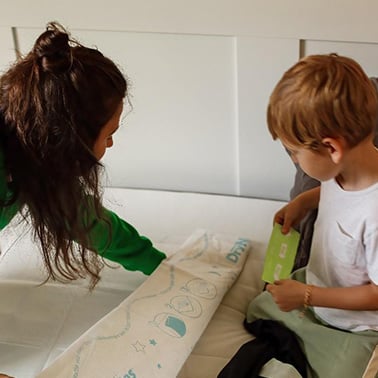Cleaning a mattress after bedwetting can seem daunting. But with the right steps, it’s manageable.
Bedwetting happens. It’s natural, especially with kids. But a wet mattress can be a hassle. It’s not just about cleaning. You need to remove stains and odors too. Proper cleaning ensures the mattress stays fresh and hygienic. Plus, it helps extend the life of your mattress.
In this blog, we’ll guide you through simple steps to clean your mattress after bedwetting. No need to stress. We’ve got practical tips to make the process easy and efficient. Let’s dive in and keep your mattress clean and comfortable.
Preparation
Cleaning a mattress after bedwetting can be a daunting task. Preparation is key to ensuring the process goes smoothly and efficiently. By gathering the right supplies and protecting the area, you can make the cleaning process easier and more effective.
Gather Supplies
Before you start cleaning, make sure you have all the necessary supplies. Having everything ready will save you time and ensure you do the job right.
- Gloves: Protect your hands from any germs or chemicals.
- Absorbent towels: These will help soak up any excess moisture.
- Baking soda: Useful for neutralizing odors and absorbing moisture.
- White vinegar: A natural cleaner that helps remove stains and odors.
- Spray bottle: To apply the vinegar solution evenly.
- Vacuum cleaner: For removing baking soda and other debris.
- Enzyme cleaner: Effective for breaking down urine stains and odors.
- Fan: To help dry the mattress faster.
Protect The Area
Before you start cleaning, it’s important to protect the surrounding area. This will help prevent any further mess and make the cleaning process easier.
- Remove bedding: Take off all sheets, mattress protectors, and pillows. Wash them separately.
- Cover the floor: Place a waterproof sheet or old towels around the mattress. This will catch any spills and protect your floor.
- Open windows: Ensure the room is well-ventilated. This helps with drying and reduces odors.
By following these preparation steps, you will be ready to clean your mattress effectively. Taking the time to gather supplies and protect the area will make the process smoother and more efficient.
Initial Steps
Blot up the excess moisture using paper towels. Sprinkle baking soda to neutralize odors. Allow it to sit before vacuuming.
Accidents happen, especially with children or pets in the house. Cleaning a mattress after bedwetting can seem daunting. But taking the right steps ensures your mattress stays fresh and clean. Let’s dive into the initial steps to tackle this issue effectively.Remove Bedding
First, strip the bed completely. Remove all sheets, blankets, and pillowcases. Place them in the laundry basket right away. This prevents the moisture from spreading. Use hot water to wash the bedding. Hot water kills bacteria and removes odors.Blot The Moisture
Next, tackle the wet spot on the mattress. Use a clean, dry towel to blot the moisture. Press down firmly to absorb as much liquid as possible. Do not rub the stain. Rubbing can spread the moisture and make it worse.Repeat blotting with fresh towels until the area feels dry. You may need several towels for this step. The goal is to remove as much moisture as possible before moving on to deeper cleaning. “`Cleaning Solution
Dealing with bedwetting can be challenging, but a good cleaning solution can help. This section will guide you through choosing and mixing an effective cleaning solution to ensure your mattress stays fresh and clean.
Choose A Cleaner
Choosing the right cleaner is crucial. Here are some options:
- Vinegar: Natural and effective against odors.
- Baking Soda: Great for absorbing moisture and odors.
- Enzymatic Cleaners: Break down stains and odors at a molecular level.
- Hydrogen Peroxide: Disinfects and removes stains.
Pick a cleaner based on what you have at home and the severity of the stain. For organic stains, enzymatic cleaners are best. For simple odor removal, vinegar or baking soda will work.
Mix The Solution
Once you have chosen your cleaner, it’s time to mix the solution.
Here’s a simple recipe:
| Ingredient | Amount |
|---|---|
| Vinegar | 1 cup |
| Water | 1 cup |
| Baking Soda | 2 tablespoons |
Mix vinegar and water in a spray bottle. Sprinkle baking soda directly on the mattress stain. Spray the vinegar solution over the baking soda. Let it sit for a few minutes. This mixture will help break down the stain and neutralize odors.
If using an enzymatic cleaner, follow the instructions on the bottle. Typically, you spray it directly on the stain and let it sit. For hydrogen peroxide, mix it with water in a 1:1 ratio and spray it on the stain. Allow it to sit and then blot with a clean cloth.

Credit: www.luce.sg
Application
Cleaning a mattress after bedwetting is essential to maintain hygiene. The application process involves applying a suitable cleaner and scrubbing gently. Let’s break down the steps to ensure thorough cleaning.
Apply Cleaner
First, choose a cleaner designed for mattresses. A mixture of white vinegar and water is effective. Combine equal parts in a spray bottle. Shake well to mix thoroughly.
Spray the solution generously over the affected area. Ensure the entire stain is covered. Avoid soaking the mattress, as this can lead to mold growth.
For tougher stains, you can use an enzyme-based cleaner. These are available in most stores. Follow the instructions on the label for best results.
Scrub Gently
Once the cleaner is applied, take a soft brush or cloth. Begin to scrub the area gently. Use circular motions to lift the stain.
Do not apply too much pressure. This could damage the mattress fibers. Be patient and let the cleaner do its job.
After scrubbing, use a clean, dry towel to blot the area. This helps to absorb excess moisture. Repeat the process if necessary, until the stain is removed.
Allow the mattress to air dry completely. Place it in a well-ventilated room or use a fan. Ensuring the mattress is completely dry prevents mold and mildew.
Drying Process
Bedwetting can be a challenging situation. Proper drying of the mattress is crucial. It prevents mold and bad odors. Here’s how to effectively dry your mattress after bedwetting.
Air Dry
Place the mattress in a well-ventilated area. Open windows to let fresh air circulate. This helps speed up the drying process. Avoid direct sunlight for extended periods. It can damage the mattress material. Rotate the mattress occasionally. This ensures even drying and prevents moisture buildup.
Use Fans
Set up fans around the mattress. Position them to blow air across the surface. This increases airflow and reduces drying time. Consider using oscillating fans. They cover a larger area and provide consistent air movement. For deeper drying, use a dehumidifier. It removes moisture from the air, aiding the drying process.
Odor Removal
Odor removal is essential after a bedwetting incident. The smell can linger and affect sleep quality. Here are some steps to help eliminate the odor and restore freshness to your mattress.
Sprinkle Baking Soda
Baking soda is a natural odor neutralizer. Start by sprinkling a generous amount over the wet area. Let it sit for several hours. This allows the baking soda to absorb moisture and odors. For best results, leave it overnight.
Vacuum Residue
Once the baking soda has done its job, it’s time to remove it. Use a vacuum cleaner with an upholstery attachment. Carefully vacuum the baking soda residue from the mattress. This will help remove any remaining odor particles.
Stain Treatment
Bedwetting can leave stubborn stains on your mattress. Treating these stains promptly is essential. This helps to maintain the cleanliness and longevity of your mattress. Here are two effective methods to tackle stains.
Spot Clean Stains
Start by blotting the wet area with a clean cloth. Press gently to soak up as much liquid as possible. Avoid rubbing, as it can spread the stain further. Use a mixture of water and mild detergent for spot cleaning. Apply the mixture to the stained area with a sponge. Blot again to lift the stain.
Use Enzyme Cleaner
Enzyme cleaners are highly effective for breaking down urine stains. Spray the enzyme cleaner on the affected area. Let it sit for 15-20 minutes. The enzymes will break down the urine particles. After waiting, blot the area with a clean cloth. This will help to remove both the stain and odor.

Credit: www.goodnites.com
Prevention Tips
Dealing with bedwetting can be challenging. But, you can take steps to prevent it from causing major headaches. These prevention tips will help you keep your mattress clean and fresh. Implementing these tips can save you time and effort.
Use Mattress Protector
A mattress protector is your first line of defense against bedwetting. It creates a barrier between the mattress and any liquids. This way, your mattress stays dry and clean.
Mattress protectors are easy to clean. Most are machine washable. This makes them a convenient choice. They come in different sizes to fit your mattress perfectly.
Look for protectors made of waterproof materials. These materials prevent any liquids from seeping through. Also, choose ones that are breathable. This ensures comfort while sleeping.
Regular Maintenance
Regular maintenance keeps your mattress in good condition. Even with a protector, it’s important to check the mattress often. This helps you spot any issues early.
Every few months, vacuum your mattress. This removes dust and allergens. It also keeps the mattress fresh. A clean mattress is less likely to develop odors or mold.
Rotate your mattress every three to six months. This prevents wear and tear. It also helps the mattress maintain its shape. A well-maintained mattress provides better support and comfort.
Follow these steps to ensure a clean and comfortable mattress:
- Use a mattress protector
- Clean your mattress regularly
- Rotate your mattress periodically
By doing these simple tasks, you can extend the life of your mattress. It also ensures a healthier sleeping environment.

Credit: www.huggies.co.uk
Frequently Asked Questions
How Do I Remove Urine Stains From A Mattress?
Blot the stain with a cloth. Apply a mixture of vinegar and water. Let it dry.
What Household Items Can Clean A Mattress?
Use baking soda, vinegar, and water. They help remove stains and odors effectively.
How Long Does It Take To Dry A Cleaned Mattress?
It typically takes 8-10 hours. Use fans or open windows to speed up drying.
Can I Use Baking Soda On A Wet Mattress?
Yes, sprinkle it on the wet area. It absorbs moisture and neutralizes odors.
How Often Should I Clean My Mattress After Bedwetting?
Clean immediately after each incident. Regular cleaning prevents stains and odors.
Conclusion
Cleaning a mattress after bedwetting can be simple. Follow these easy steps. First, remove the bedding and wash it. Next, blot the wet area with a clean towel. Apply a mixture of water and vinegar to neutralize odors. Let it air dry completely.
Finally, sprinkle baking soda on the spot and vacuum after a few hours. Your mattress will be fresh and clean. Consistent care will keep it in great shape. Happy cleaning!
